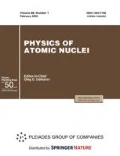Abstract
A series of chemical reactions is suggested to describe primary chemical transformations induced by Auger electrons from radioactive nuclear decay in glassy and crystalline frozen aqueous media. The mechanism is based on Mössbauer emission spectroscopy data supplemented by data on reactions in the tracks of fast positrons and electrons in an aqueous medium. It is shown that variation of temperature, the degree of crystallinity, the concentration of electron acceptors, etc., results in correlated changes in the yields of the final reaction products—Fe2+, Fe3+ or Sn2+, Sn4+ ions, positronium atoms, and molecular radiolytic hydrogen. These correlations indicate the similarity of chemical processes in the nanometer vicinity of decayed 57Co and 119mSn nuclei and in the tracks of fast positrons and electrons. This similarity is caused by the same behavior of secondary intratrack electrons produced due to ionization losses of fast positrons, electrons, and Auger electrons.
Similar content being viewed by others
References
Mössbauer Spectroscopy of Frozen Solutions, Ed. by A. Vértes and D. L. Nady (Académiai Kiadó, Budapest, 1990; Mir, Moscow, 1998).
A. K. Pikaev, Modern Radiation Chemistry. Basic Principles. Experimental Technique and Methods (Nauka, Moscow, 1985) [in Russian].
V. M. Byakov and F. G. Nichiporov, Intratrack Chemical Processes (Énergoatomizdat, Moscow, 1985) [in Russian].
Principles and Applications of Positron and Positronium Chemistry, Ed. by Y. C. Jean, P. E. Mallone, and D. M. Schrader (World Sci., Singapore, 2003).
J. M. Friedt and J. Danon, At. Energy Rev. 184, 893 (1980).
Yu. D. Perfil’ev, Izv. Ross. Akad. Nauk, Ser. Fiz. 63, 1383 (1999).
H. Pollak, Phys. Status Solidi 2, 720 (1961).
L. A. Kulikov, L. T. Bugaenko, Yu. D. Perfil’ev, and A. M. Babeshkin, Vestn. Mosk. Univ., Ser. 2: Khim., No. 3, 347 (1972).
Yu. D. Perfil’ev, L. A. Kulikov, V. M. Byakov, et al., Khim. Vys. Energ. 37, 390 (2003) [High Energy Chem. 37, 345 (2003)].
S. I. Bondarevskii and N. E. Ablesimov, Khim. Vys. Energ. 11, 285 (1977) [High Energy Chem. 11, 239 (1977)].
A. Namiki, M. Noda, and T. Higashimura, J. Phys. Chem. 79, 2975 (1975).
J. H. Baxendale and P. Wardman, J. Chem. Soc., Faraday Trans. 1 3, 584 (1973).
V. M. Byakov, J. Phys. IV, Colloq. C4, Suppl. II 3, 85 (1993).
Yu. D. Perfiliev, L. A. Kulikov, L. T. Bugaenko, et al., J. Inorg. Nucl. Chem. 36, 2115 (1976).
K. Y. Lam and J. W. Hunt, Int. J. Radiat. Phys. Chem. 7, 317 (1975).
V. M. Byakov, V. I. Grafutin, O. V. Koldaeva, et al., Preprint ITÉF-37 (Institute of Theoretical and Experimental Physics, Moscow, 1984).
G. P. Chernova, B. G. Ershov, and A. K. Pikaev, Izv. Akad. Nauk SSSR, Ser. Khim., No. 1, 43 (1970).
M. Faraggi, Int. J. Radiat. Phys. Chem. 5, 197 (1973).
Ya. M. Mil’grom, Yu. D. Perfil’ev, and A. M. Babeshkin, Khim. Vys. Energ. 12, 272 (1978).
B. Levay and P. Hautojarvi, J. Phys. Chem. 76, 1951 (1972).
E. Hart and M. Anbar, The Hydrated Electron (Wiley, New York, 1970; Atomizdat, Moscow, 1973).
CRC Handbook of Chemistry and Physics, 78th ed., Ed. by D. R. Lide (CRC Press, Boca Raton; New York, 1998).
Yu. D. Perfil’ev, L. A. Kulikov, and A. M. Babeshkin, Zh. Fiz. Khim. 52, 1631 (1978) [Russ. J. Phys. Chem. 82, 1045 (1978)].
V. M. Byakov and S. V. Stepanov, Nukleonika 42, 45 (1997).
S. J. Tao and J. H. Green, J. Phys. Chem. 73, 882 (1969).
J. W. Boyle, Radiat. Res. 17, 427 (1962).
D. Katakis and A. O. Allen, J. Phys. Chem. 68, 3107 (1964).
M. Domae, Y. Katsumura, K. Ishigure, and V. M. Byakov, Radiat. Phys. Chem. 48, 487 (1996).
Author information
Authors and Affiliations
Additional information
__________
Translated from Yadernaya Fizika, Vol. 68, No. 6, 2005, pp. 1054–1063.
Original Russian Text Copyright © 2005 by Byakov, Kulikov, Perfil’ev, Stepanov.
Rights and permissions
About this article
Cite this article
Byakov, V.M., Kulikov, L.A., Perfil’ev, Y.D. et al. Primary chemical reactions induced by radioactive nuclear transformations. Phys. Atom. Nuclei 68, 1016–1024 (2005). https://doi.org/10.1134/1.1954828
Received:
Accepted:
Issue Date:
DOI: https://doi.org/10.1134/1.1954828



